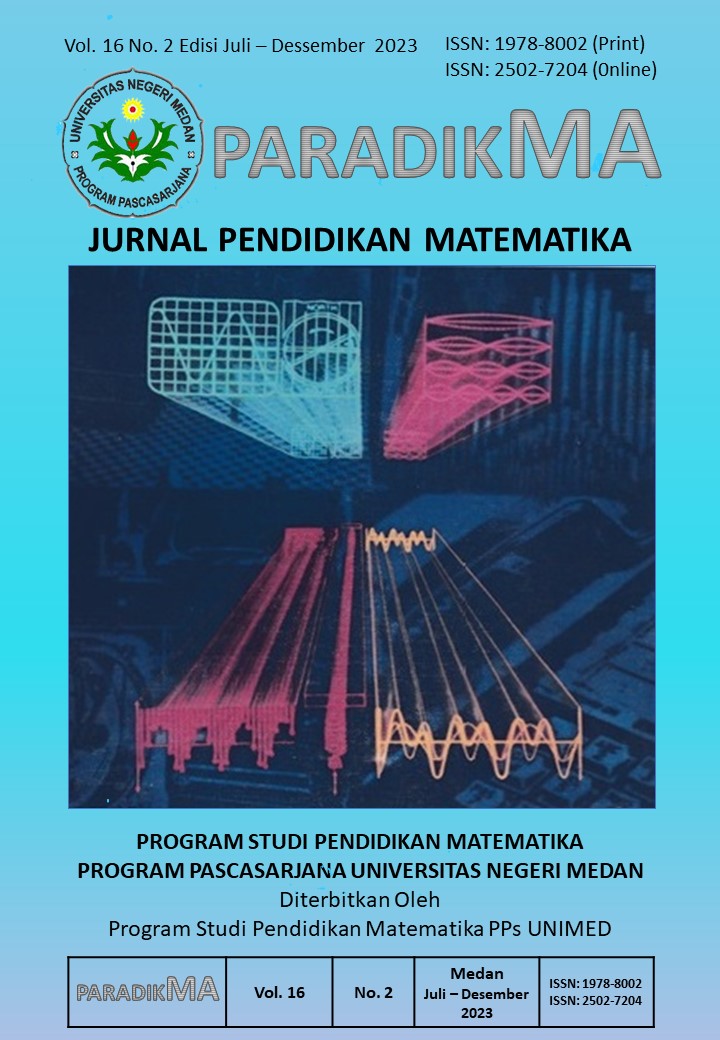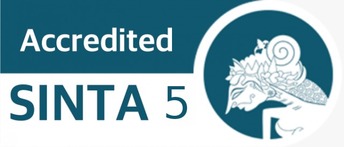Development of Learning Devices Based on Realistic Mathematical Learning Models to Improve Mathematical Literary Ability
DOI:
https://doi.org/10.24114/paradikma.v16i2.47784Abstract
The limited usage and repurposing of media in education served as the driving force behind this study. Student Textbooks and Student Worksheets (LKPD) are designed to support instruction. Additionally, Systems of Two Variable Linear Equations (SPLDV) implicit graphical problem solutions are made possible with the use of GeoGebra media. In this inquiry, interactive learning tools for the SPLDV curriculum will be made using GeoGebra. The 4-D Thiagaradjan model serves as a model in this study on development. Define, design, develop, and deploy are the four stages. This experiment involved eighth-graders aged 14 and two eighth-grade math teachers. Utilizing a requirements analysis, interviews, and questionnaires, observational data was gathered. An study of the data collection process's demands, as well as interviews and surveys, are all included. Validity, practicability, and efficacy were three essential development conditions that had to be met before a study could be put into action. Proportion scores were validated by two qualified validators to support the study's conclusions. For learning device formats, graphics, language, and content validation, the average score is 3.78. (Applicable classifications). The effective category, which received an average score of 74.3 on the pretest and 87 on the posttest, the complete category, which served as a gauge of the teacher's capacity to manage learning and received an average score of 4.4 in the very good category, and the practical category, which also received an average score of 4.4 in the very good category, served as the foundation for the research findings. As a result, improving student performance can be accomplished through the development of learning tools based on realistic learning models.Keywords: Development of Learning Devices, Thiagaradjan 4-D Model, Realistic Mathematical Education (RME), Mathematical Literacy.References
Asmin, M. (2012). Pengukuran dan Penilaian Hasil Belajar. Medan: Larispa Indonesia.
Astuti. (2018). Penerapan Realistic Mathematic Education (RME) Meningkatkan Hasil Belajar Matematika Siswa Kelas VI SD. Journal Cendekia: Jurnal Pendidikan Matematika. https://media.neliti.com/media/publications/269821-penerapan-realistic-mathematic-education-bf7883d5.pdf
Daniyati, Nadzifah Ajeng, Sugiman. (2015). Hubungan Antara Kemampuan Verbal, Kemampuan Interpersonal, dan Minat Belajar dengan Prestasi Belajar Matematika. PYTHAGORAS: Jurnal Pendidikan Matematika, 10(1). https://journal.uny.ac.id/index.php/pythagoras/article/view/9109/pdf
Hasanah, (2015). Peningkatan Kemampuan Literasi dan Disposisi Matematis Siswa SMP Melalui Pendekatan Pembelajaran Model Elicting Activities (MEAS), Yogyakarta: UIN Sunan Kalijaga, 2015.
Lestari, K. E., dan Yudhanegara, M. R. (2015). Penelitian Pendidikan Matematika. Refika Aditama
Lubis, Wilda Indah Yonalia, dkk. (2020). pengembangan perangkat pembelajaran matematika untuk meningkatkan kemampuan berpikir kritis dan self efficacy siswa dengan menggunakan model problem based learning di sma sultan iskandar muda t.a 2017/2018. paradikma jurnal pendidikan matematika. https://jurnal.unimed.ac.id/2012/index.php/paradikma/article/download/22917/15067
Mansur, N. (2018). Melatih Literasi Matematika Siswa dengan Soal PISA. Prisma, 1, 140“144.
Ningsih, Seri. (2014). Realistic Mathematics Education: Model Alternatif Pembelajaran Matematika Sekolah. JPM IAIN Antasari. https://media.neliti.com/media/publications/121158-ID-none.pdf
Nasution, Zulaini Masruro, dkk. (2017). Perbedaan Kemampuan Pemecahan Masalah Matematik dan Motivasi Belajar Siswa yang diberi Pendekatan Pembelajaran Berbasis Masalah dengan Pendidikan Matematika Realistik di SMP Negeri 3 Tebing Tinggi. Universitas Negeri Medan: Paradikma Jurnal Pendidikan Matematika. Vol. 10, No. 1. https://jurnal.unimed.ac.id/2012/index.php/paradikma/article/view/8688
Permendikbud No. 65 Tahun (2013) Tentang Standar Proses Pendidikan Dasar dan menengah. Jakarta: Permendikbud.
Pusat Penilaian Pendidikan Balitbang Kemendikbud. (2019). Pendidikan di Indonesia Belajar dari Hasil PISA Programme For International Student Assessment.https://repositori.kemdikbud.go.id/16742/1/Laporan%20Nasional%20PISA%202018%20Indonesia.pdf
Rahmat , Psikologi Pendidikan. Jakarta Timur: PT Bumi Aksara, 2018.
Romlah, dkk. (2018). Melatihkan Keterampilan Berpikir Kreatif Siswa SD Melalui Permainan. Jurnal Review Pendidikan Dasar: Jurnal Kajian Pendidikan dan Hasil Penelitian. https://journal.unesa.ac.id/index.php/PD/article/download/4249/2348.
Simanullang, M. C. (2018). Pengembangan Model Pembelajaran Pendidikan Matematika Realistik (PMR) untuk Meningkatkan Kecerdasan Triarkis dan Kemandirian Belajar Siswa Kelas VII SMP Sutomo 1 Medan. Tesis. Medan: PPs UNIMED.
Sinaga, Bornok dkk., (2016), Pengembangan Model Pembelajaran Matematika Berdasarkan Masalah Berbasis Budaya Batak (PBM-B3), Pendidikan Matematika.
Sugiarni, R. & Kurniawati, N. (2019). Penerapan Media Ajar Digital Berbasis 4c (Communication, Collaboration, Critical Thinking And Problem Solving, dan Creativity and Innovation) Dalam Menghadapi Revolusi Industri 4.0 Di Kalangan Guru Yayasan Mandiri Bersemi. Jurnal Qardhul Hasan; Media Pengabdian kepada Masyarakat p-ISSN 2442-3726 e-ISSN 2550- 1143 Volume 5 Nomor 2, Oktober 2019.







